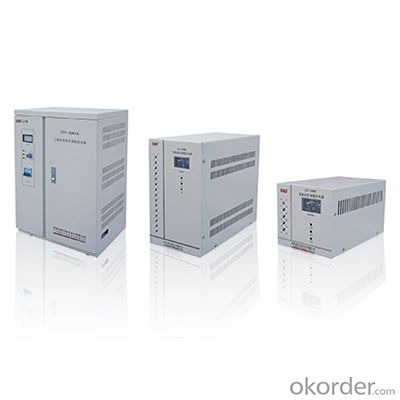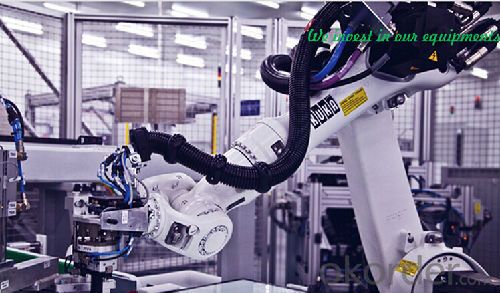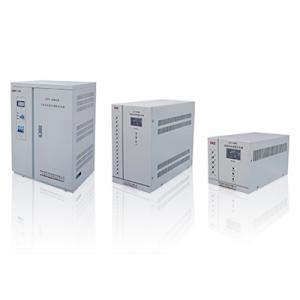0.5-30KVA Power Inverter with Charger Fully Automatic AC Stabilized Power Supply
- Loading Port:
- China main port
- Payment Terms:
- TT or LC
- Min Order Qty:
- 1 pc
- Supply Capability:
- 1000 pc/month
OKorder Service Pledge
OKorder Financial Service
You Might Also Like
ZTY series high accuracy fully automatic AC stabilized Power Supply is a key series of our stabilizing products. It mainly consists of auto-transformer, servo motor, automatic control circuit. When the utility is not stable or the load fluctuates, the automatic control circuit modifies the control output according to the input voltage change of power supply, with driving the servo motor, and then the servo motor adjusting the carbon brush of auto-transformer to regulate the output voltage at its rating and remain stable.
Single Phase | |||||||||
VA Rating | 0.5KVA | 1KVA | 2KVA | 3KVA | 5KVA | 10KVA | 15KVA | 20KVA | 30KVA |
INPUT | |||||||||
Phase | Single Phase+N+GND | ||||||||
Voltage Range | 160Vac-250Vac | ||||||||
OUTPUT | |||||||||
Voltage | 220V | ||||||||
Voltage Precision | ≤±3% | ||||||||
Frequency | 50/60Hz | ||||||||
Over-Voltage Protection | Output Voltage 250V±5V | ||||||||
Low-Voltage Protection | Output Voltage 183V±5V | ||||||||
Efficiency | ≥96% | ||||||||
OTHERS | |||||||||
Display Mode | LED / METER | ||||||||
Input/Output Device | Optional Plug; Socket / Terminal | ||||||||
Waveform Distortion | No affixation Waveform Distortion | ||||||||
Response Time | (±10% Varies) <1s | ||||||||
Insulation Resistance | ≥2MΩ | ||||||||
Anti-Electricy Intension | Low frequency sine voltage 1500V take 1 minute no rout and camber phenomena | ||||||||
Ambient Temperature | 0℃-40℃ | ||||||||
Relative Humidity | ≤95% | ||||||||
Working | Continue | ||||||||
Dimension(WxDxH)mm | 150x247x144 | 150x247x200 | 150x285x260 | 175x360x305 | 220x485x430 | 330x370x612 | 530x400x732 | ||
Net Weight(kg) | 4.3 | 4.8 | 8.2 | 9.5 | 15.2 | 31 | 53 | 59 | 91 |
Packing(WxDxH)mm | 235x360x235 | 235x360x290 | 230x395x350 | 278x470x415 | 280x555x495 | 430x500x690 | 635x500x830 | ||
Gross Weight(kg) | 4.8 | 5.3 | 8.8 | 10.1 | 15.9 | 32 | 56 | 61.3 | 94.5 |
MODEL | ZTY Three Phase | |||||
VA Rating | 3KVA | 6KVA | 10KVA | 15KVA | 20KVA | 30KVA |
INPUT | ||||||
Phase | Three Phase+N+GND | |||||
Voltage Range | Line Voltage 277Vac-433Vac | |||||
OUTPUT | ||||||
Voltage | 380V | |||||
Voltage Precision | ≤±3% | |||||
Frequency | 50/60Hz | |||||
Over-Voltage Protection | Output Voltage 250V±5V | |||||
Low-Voltage Protection | Output Voltage 183V±5V | |||||
Efficiency | ≥96% | |||||
OTHERS | ||||||
Display Model | LED / METER | |||||
Input/Output Device | Terminal | |||||
Waveform Distortion | No Affixation Waveform Distortion | |||||
Response Time | (±10% Varies) <1s | |||||
Insulation Resistance | ≥2MΩ | |||||
Anti-Electricy Intension | Low Frequency Sine Voltage 1500V Take 1 minute No Rout and Camber phenomena | |||||
Ambient Temperature | 0℃-40℃ | |||||
Relative Humidity | ≤95% | |||||
Working | Continue | |||||
Dimension(WxDxH)mm | 200x480x395 | 330x350x702 | 330x380x752 | 530x400x732 | ||
Net Weight(kg) | 14.5 | 35 | 37 | 51 | 58 | 95 |
Packing(WxDxH)mm | 260x555x505 | 460x435x790 | 555x420x840 | 635x500x830 | ||
Gross Weight(kg) | 16.8 | 37.6 | 40 | 54.2 | 61.6 | 105 |
· Q. What is an UPS and What it is for ?
An uninterruptible power supply (UPS) is a device that allows your computer or telephone switch or critical equipement to keep running for at least a short time or longer time when the primary power source is lost. It also provides protection from power surges, spikes, brownouts, interference and other unwanted problems on the supported equipment.
· Q. How long the UPS to run when power goes?
This can take 3 paths.
1.You can pick a UPS that is rated for pretty much the full VA you need so it will be running at 100% of capability and will thus last 'n' minutes.
2.You can pick a UPS that is rated at a much higher VA value than you really need so, for example, is running at 50% of capability and will thus last for longer than the UPS from option 1.
3.You can use extra external battery packs to run for longer. If charging capability allows, the more and the bigger batteries you take with, the longer time UPS runs.
or using a generator after about 6 hours, it will be more cost-effective, with a short runtime UPS to bridge the generator start-up gap.



- Q:Can a solar inverter be connected to a backup battery system?
- Yes, a solar inverter can be connected to a backup battery system. This allows the solar energy generated during the day to be stored in the backup batteries and used during times when there is no sunlight or during power outages.
- Q:What is the lifespan of a solar inverter?
- The lifespan of a solar inverter typically ranges from 10 to 15 years, depending on various factors such as the quality of the inverter, proper maintenance, and operating conditions.
- Q:Can a solar inverter be used with different types of monitoring systems?
- Yes, a solar inverter can be used with different types of monitoring systems. Solar inverters are designed to convert the direct current (DC) electricity produced by solar panels into alternating current (AC) electricity that can be used in homes or businesses. While some inverters come with built-in monitoring systems, they can also be connected to external monitoring systems that provide more advanced data and analytics. This allows users to monitor and manage their solar power generation and consumption effectively, regardless of the monitoring system they choose to use.
- Q:What is the role of a transformer in a solar inverter?
- The role of a transformer in a solar inverter is to convert the direct current (DC) power generated by the solar panels into alternating current (AC) power that can be used by household appliances and fed into the electrical grid. The transformer steps up or steps down the voltage as necessary to ensure efficient power transmission and distribution. Additionally, it provides electrical isolation and protection from voltage fluctuations, ensuring the safe and reliable operation of the solar inverter.
- Q:Can a solar inverter be used with solar-powered water pumps?
- Yes, a solar inverter can be used with solar-powered water pumps. A solar inverter is responsible for converting the direct current (DC) produced by solar panels into alternating current (AC) that can power electrical devices, including water pumps. This allows the solar panels to directly power the water pumps, making them suitable for off-grid or remote locations where access to electricity is limited.
- Q:How is the output voltage and frequency of a solar inverter regulated?
- The output voltage and frequency of a solar inverter are regulated through advanced control algorithms and feedback mechanisms. These control algorithms continuously monitor the input power generated by the solar panels and adjust the inverter's output voltage and frequency accordingly. The regulation process involves various components such as voltage regulators, frequency detectors, and digital signal processors that ensure the output voltage and frequency are in sync with the grid or the desired specifications. Additionally, some inverters may also have built-in mechanisms to protect against voltage and frequency fluctuations, ensuring a stable and reliable power supply to connected devices or the grid.
- Q:Can a solar inverter be used with a solar-powered remote sensing system?
- Yes, a solar inverter can be used with a solar-powered remote sensing system. The solar inverter is responsible for converting the direct current (DC) generated by the solar panels into alternating current (AC) that can be used to power the remote sensing system.
- Q:Can a solar inverter be used with thin-film solar panels?
- Yes, a solar inverter can be used with thin-film solar panels. Thin-film solar panels have different characteristics than traditional crystalline panels, but they still generate DC power that needs to be converted into AC power for use in homes or businesses. Solar inverters are designed to convert the DC power from any type of solar panel, including thin-film, into usable AC power.
- Q:What is the role of voltage regulation in a solar inverter?
- The role of voltage regulation in a solar inverter is to ensure that the voltage output from the solar panels is converted and maintained at a stable and appropriate level for efficient and safe operation of electrical devices or for grid connection. This regulation helps to optimize the performance of the solar inverter and prevents voltage fluctuations that could potentially damage or disrupt the functioning of connected equipment.
- Q:What is the role of a solar inverter in a residential system?
- The role of a solar inverter in a residential system is to convert the direct current (DC) electricity produced by the solar panels into alternating current (AC) electricity that can be used to power household appliances and be fed into the electrical grid. It ensures efficient use of solar energy and enables easy integration of solar power into the existing electrical infrastructure of a home.
1. Manufacturer Overview |
|
|---|---|
| Location | |
| Year Established | |
| Annual Output Value | |
| Main Markets | |
| Company Certifications | |
2. Manufacturer Certificates |
|
|---|---|
| a) Certification Name | |
| Range | |
| Reference | |
| Validity Period | |
3. Manufacturer Capability |
|
|---|---|
| a)Trade Capacity | |
| Nearest Port | |
| Export Percentage | |
| No.of Employees in Trade Department | |
| Language Spoken: | |
| b)Factory Information | |
| Factory Size: | |
| No. of Production Lines | |
| Contract Manufacturing | |
| Product Price Range | |
Send your message to us
0.5-30KVA Power Inverter with Charger Fully Automatic AC Stabilized Power Supply
- Loading Port:
- China main port
- Payment Terms:
- TT or LC
- Min Order Qty:
- 1 pc
- Supply Capability:
- 1000 pc/month
OKorder Service Pledge
OKorder Financial Service
Similar products
New products
Hot products
Hot Searches
Related keywords































